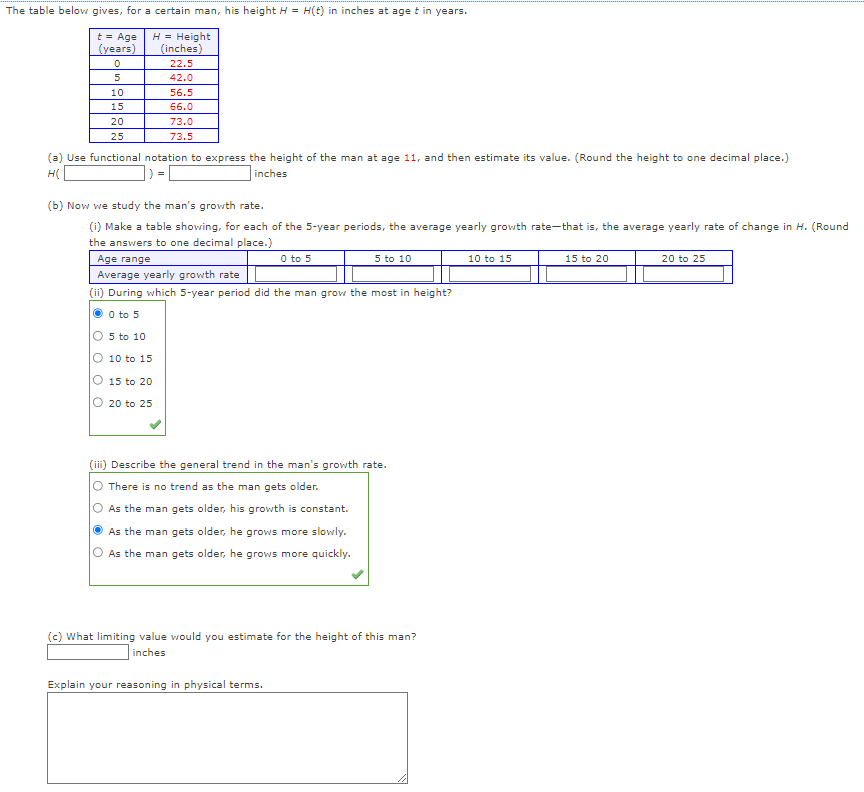The table below gives, for a certain man, his height H = H(t) in inches at age t in years. t = Age (years) H = Height (inches) 0 22.5 5 42.0 10 15 20 25 56.5 66.0 73.0 73.5 (a) Use functional notation to express the height of the man at age 11, and then estimate its value. (Round the height to one decimal place.) H( inches (b) Now we study the man's growth rate. (i) Make a table showing, for each of the 5-year periods, the average yearly growth rate-that is, the average yearly rate of change in H. (Round the answers to one decimal place.) Age range 0 to 5 Average yearly growth rate (ii) During which 5-year period did the man grow the most in height? 0 to 5 5 to 10 10 to 15 15 to 20 20 to 25 5 to 10 (iii) Describe the general trend in the man's growth rate. There is no trend as the man gets older. As the man gets older, his growth is constant. As the man gets older, he grows more slowly. As the man gets older, he grows more quickly. (c) What limiting value would you estimate for the height of this man? inches Explain your reasoning in physical terms. 10 to 15 15 to 20 20 to 25
The table below gives, for a certain man, his height H = H(t) in inches at age t in years. t = Age (years) H = Height (inches) 0 22.5 5 42.0 10 15 20 25 56.5 66.0 73.0 73.5 (a) Use functional notation to express the height of the man at age 11, and then estimate its value. (Round the height to one decimal place.) H( inches (b) Now we study the man's growth rate. (i) Make a table showing, for each of the 5-year periods, the average yearly growth rate-that is, the average yearly rate of change in H. (Round the answers to one decimal place.) Age range 0 to 5 Average yearly growth rate (ii) During which 5-year period did the man grow the most in height? 0 to 5 5 to 10 10 to 15 15 to 20 20 to 25 5 to 10 (iii) Describe the general trend in the man's growth rate. There is no trend as the man gets older. As the man gets older, his growth is constant. As the man gets older, he grows more slowly. As the man gets older, he grows more quickly. (c) What limiting value would you estimate for the height of this man? inches Explain your reasoning in physical terms. 10 to 15 15 to 20 20 to 25
Algebra & Trigonometry with Analytic Geometry
13th Edition
ISBN:9781133382119
Author:Swokowski
Publisher:Swokowski
Chapter4: Polynomial And Rational Functions
Section4.6: Variation
Problem 8E
Related questions
Question
10

Transcribed Image Text:The table below gives, for a certain man, his height H = H(t) in inches at age t in years.
t = Age
(years)
H = Height
(inches)
0
22.5
5
42.0
10
15
20
25
(a) Use functional notation to express the height of the man at age 11, and then estimate its value. (Round the height to one decimal place.)
H(
inches
56.5
66.0
73.0
73.5
(b) Now we study the man's growth rate.
(i) Make a table showing, for each of the 5-year periods, the average yearly growth rate-that is, the average yearly rate of change in H. (Round
the answers to one decimal place.)
Age range
10 to 15
15 to 20
20 to 25
Average yearly growth rate
(ii) During which 5-year period did the man grow the most in height?
Ⓒ 0 to 5
O 5 to 10
0 to 5
5 to 10
(iii) Describe the general trend in the man's growth rate.
There is no trend as the man gets older.
As the man gets older, his growth is constant.
As the man gets older, he grows more slowly.
As the man gets older, he grows more quickly.
Explain your reasoning in physical terms.
(c) What limiting value would you estimate for the height of this man?
inches
10 to 15
15 to 20
20 to 25
Expert Solution
This question has been solved!
Explore an expertly crafted, step-by-step solution for a thorough understanding of key concepts.
This is a popular solution!
Trending now
This is a popular solution!
Step by step
Solved in 2 steps with 3 images

Recommended textbooks for you

Algebra & Trigonometry with Analytic Geometry
Algebra
ISBN:
9781133382119
Author:
Swokowski
Publisher:
Cengage


Algebra & Trigonometry with Analytic Geometry
Algebra
ISBN:
9781133382119
Author:
Swokowski
Publisher:
Cengage
